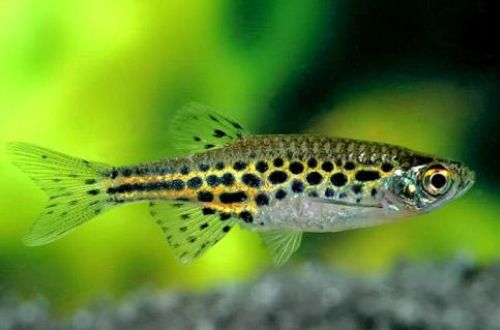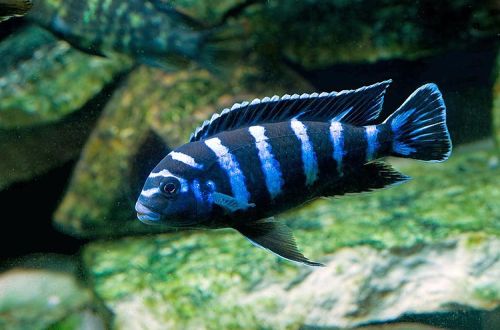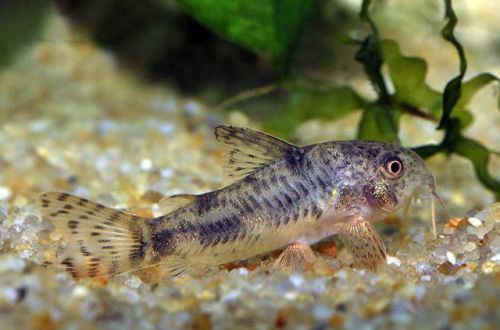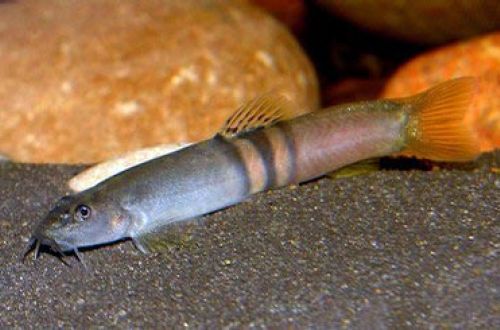
Danio Tinwini
Danio Tinwini, Danio “Golden Rings” or Spotted Burmese Danio, scientific name Danio tinwini, belongs to the Cyprinidae family. The fish got one of its names in honor of the collector and major exporter of freshwater fish U Tin Win from Myanmar. Available in the aquarium hobby since 2003. Easy to keep and whimsical fish that can get along with many other freshwater species.

Contents
Habitat
It comes from Southeast Asia from the territory of northern Myanmar (Burma). Inhabits the upper basin of the Irrawaddy River. It occurs in small channels and streams, less often in the main riverbed. Prefers regions with calm waters and an abundance of aquatic vegetation.
Brief information:
- The volume of the aquarium – from 40 liters.
- Temperature – 18-26°C
- Value pH — 6.5–7.5
- Water hardness – 1–5 dGH
- Substrate type – soft dark
- Lighting – subdued
- Brackish water – no
- Water movement – light or moderate
- The size of the fish is about 2-3 cm.
- Feeding – any food of suitable size
- Temperament – peaceful
- Keeping in a group of 8-10 individuals
Description
Adult individuals reach a length of about 2-3 cm. The body pattern consists of black dots on a golden background, reminiscent of a leopard pattern. The fins are translucent and also speckled. Belly silvery. Sexual dimorphism is weakly expressed.
Food
Undemanding to the composition of food. Accepts most popular foods in the aquarium trade in the right size. These can be dry flakes, granules and/or live or frozen bloodworms, brine shrimp, daphnia, etc.
Maintenance and care, arrangement of the aquarium
The size of an aquarium for a flock of 8-10 fish should start from 40 liters. The design is arbitrary, provided that dark soil and a large number of aquatic plants are used. The presence of snags and other natural elements is welcome. The lighting is subdued. It is noted that with an excess of light in a half-empty tank, the fish become faded.
Danio Tinvini is able to live in moderate currents and needs clean, oxygen-rich water. In turn, rich flora can produce a lot of excess organic matter in the form of dying leaves, as well as lead to an excess of carbon dioxide at night, when photosynthesis stops and plants begin to consume oxygen produced during the day. Perhaps the best solution would be artificial plants.
To maintain the ecological balance, it is necessary to install a productive filtration and aeration system and regularly maintain the aquarium. The latter usually includes several standard procedures: weekly replacement of part of the water with fresh water, cleaning the soil from organic waste (excrement, food debris), equipment maintenance, monitoring and maintaining stable pH and dGH values.
Behavior and Compatibility
Active peaceful fish. Compatible with other non-aggressive species of comparable size. Any large fish, even if it is a vegetarian, should be excluded. Danio “Golden Rings” prefer to be in a group of at least 8-10 individuals. A smaller amount negatively affects behavior, and in some cases, for example, single or pair keeping, leads to a significant reduction in life expectancy.
Breeding / breeding
Breeding is simple and does not require large time and financial costs. Under favorable conditions, spawning occurs throughout the year. Like most cyprinids, these fish scatter many eggs among the thickets of plants and this is where their parental instincts end. The incubation period lasts 24–36 hours, after a couple of days the fry that have appeared begin to swim freely. Since Danios do not take care of their offspring, the survival rate of juveniles will be extremely low if they are not transplanted into a separate tank in time. As the latter, a small container with a volume of 10 liters or more, filled with water from the main aquarium, is suitable. The set of equipment consists of a simple airlift filter and a heater. A separate light source is not required.
Fish diseases
In a balanced aquarium ecosystem with species-specific conditions, diseases rarely occur. Often, diseases are caused by environmental degradation, contact with sick fish, and injuries. If this could not be avoided and the fish shows clear signs of illness, then medical treatment will be required. Read more about symptoms and treatments in the Aquarium Fish Diseases section.





